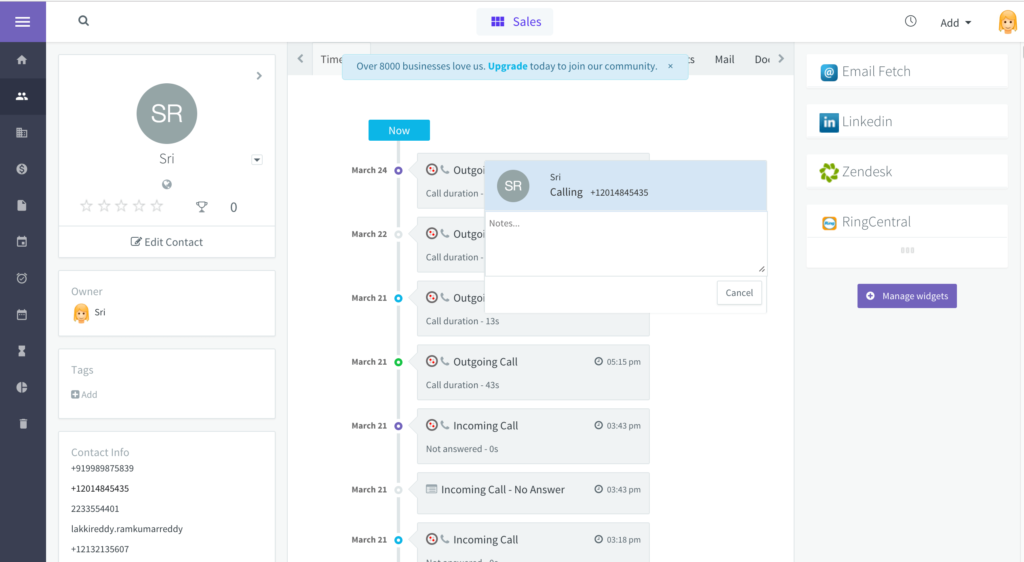A successful and sustainable business depends on one thing: sales.
If a company isn’t selling their products or services, it doesn’t matter how “great” or “different” they are. Without connecting with people who actually want to purchase what they’re offering, the business is never going to get off the ground.
But sales is a complicated process. It’s more than just exchanging an item for money—there’s finding the right leads, managing the sales team, and continuously engaging with customers to encourage them to buy again.
In order for a business (regardless of size or industry) to be successful, it needs strong sales management.
Sales management is an all-encompassing term that includes the process of hiring, training, and managing sales teams, as well as implementing new sales techniques, measuring how well a team or individual is performing, and tracking sales initiatives to see if targets or goals are being met.
But what does this really look like for a small business—especially one just getting off the ground? Keep reading to find out:
- Why is sales management important?
- What does sales management look like?
- How to create an effective sales management process
Up your team’s sales game and help them close more deals with these free cold outreach scripts. ☎️
Why is sales management important?
Take a minute to imagine your sales team. Regardless of how big (or small) it is, your sales reps probably have different personalities, selling styles, or tactics that make them good at their jobs. Having a team that looks and acts a little different can be great for closing deals.
But without any guidelines or standardized processes, your sales team can feel disjointed. If they’re all sharing different information, logging their deals in different systems, or just working completely on their own, sales can be inefficient and difficult to keep an eye on.
This is where sales management comes in. Sales management adds some structure to your sales process—directly benefiting everyone from your customer base to your business owner.
Good sales management benefits your customers
When customers engage with your sales team, they learn to expect the same interactions, information, and processes regardless of who they talk to. If they call one day and talk to Salesperson Tom, they’re going to expect the same level of helpfulness and friendliness from Salesperson Sally.
Without sales management, it’s harder to maintain consistency between teams. A prospect might not get the same experience each time they call and ask for help, and with salespeople operating from their own processes and content, the support the prospect receives can be hit or miss. In the end, the lack of consistency and reliability can push the them away—potentially for good.
Sales management processes help put that standardization in place so prospects know exactly what they’re getting every time they reach out. While your sales team might still have their own personalities, they’ll be working from the same systems and content, so support can be more consistent.
Good sales management benefits your sales team
A job in sales is often pretty independent. While teams may try and meet quotas together, actual sales usually happen one-to-one.
Without clear management processes, this means salespeople need to discover their own way of doing things or rely on a more senior team member to take them under their wing. This can not only create unproductive competition and resentment in the department, but means sales professionals might prioritize their own success over the success of the team.
A good sales manager brings every team member on the same page. Because you’re tracking, training, and supporting each sales team member in the same way, your team can start empowering—rather than competing—with one another.
Good sales management benefits the company’s owner
Implementing new management systems can be a bit of a headache. It often requires new tools and training, and always takes a bit of time for the team to get used to.
But with effective sales management, the end result is usually more productive team members and happier customers. With the right sales management processes in place, your team can sell more products, customers will feel more confident in their purchasing decisions, and the company as a whole will produce more revenue.
What does sales management look like?
“Management” sounds like a big thing that’s kind of fuzzy and not exactly concrete when it comes to what you need to do. But sales management can actually be broken down into three main parts:
- Operations
- Strategy
- Analysis
Let’s take a closer look at what each of these mean and what management looks like at each stage.
1. Operations
Your sales operations are essentially your sales team: who they are, how they work, and how they develop their skills and gain experience. The first part of your management process is to figure out what your sales team looks like. And that starts with onboarding.
Onboarding
Properly managing your sales process begins with finding and hiring the right talent. While in sales it might be tempting to bring on new hires with the best sales record, that’s not always the best decision for building your team.
Your sales team is representative of your brand. They’re often the first face a prospect sees within your company, so you need to think about the image they’re projecting. If they’re just using whatever tactic possible to close a deal, you could end up with a bad reputation (and tanking your customer retention rate).
When finding and onboarding talent, think of each salesperson as an extension of your company. Make sure they have the right skills and experience, but also that they’re the kind of person you want representing your company.
Training
Once you’ve assembled your sales team, you want to be sure they’re all up to speed on how they should be working. While we will talk about how to set your sales strategy and the processes that go along with that, you want to get your sales team the appropriate training so they can start pitching as soon as possible.
Train your team on the systems and tools they’ll be using, as well as how they can work together as a team. Rather than viewing each salesperson as an independent rep, imagine them all as pieces of the same machine. They should function best when working together.
How can they sell as a team? How can they share information about prospects and potential customers to close more deals—together?
This is one area where technology is really underrated—having a good outbound contact center tool can be a huge help for, say, logging the most successful scripts for your reps, your prospects’ communication preferences, and so on:
Setting goals
Quotas and targets are a big part of a sales team moving a company forward, but setting those goals needs to be a strategic process. Sure, selling more always sounds better and you want to make as many deals as possible, but if you’re setting your team up to fail, you might end up demoralizing them—which isn’t going to help your numbers.
Don’t just give your team a target and tell them to get there by any means necessary. As a sales manager or business owner, it’s your job to help them reach their goals. Help them find the motivation, train them on how to run a great sales demo, and support them through mentorships or coaching that they need.
And be sure to track and analyze your sales success (we’ll get to that in a bit).
2. Strategy
Your team is in place, they’re ready to go, and they know what targets they need to reach—now all they need is the strategy to make that happen.
Your sales strategy is how you sell, or your “sales pipeline.” It’s a visual representation of the different phases of your sales process, from prospecting to closing the deal, as well as a breakdown of what happens at each phase.
The sales pipeline should guide your team through the selling process. Not only should it tell them what questions their customer might be asking at each phase or what content they might be looking for, but it should also tell them when a customer is ready to move on to the next phase of the process.
Managing the strategy means looking into the little details, behaviors, and needs of each client during each sales pipeline phase. When does someone move from a lead to a prospect? What makes them qualified? Where might customers not be getting the support they need? These are all questions you need to answer.
Don’t try to do this part alone. Bring your sales team in on the strategizing process. Getting insight from everyone who is working directly with clients can bring new perspectives, alternative solutions, or just new ideas to your sales strategy—keeping your pipeline as functional as possible.
3. Analysis
The management process isn’t over when the customer makes a purchase. Now’s the time to judge your performance.
Analyzing each sale, how smoothly it moved through the sales funnel, or what snags it hit along the way lets you go back and change what’s necessary and strengthen what already works.
But proper analysis is more than just saying something is “good” or “bad.” Here’s how to conduct a good analysis of your sales process:
- Know your KPIs. Your key performance indicators (KPIs) are the metrics you’ve deemed most important to your sales process. Average deal size, conversion rate, number of deals in your funnel, or average deal lifetime are all metrics you could use to get started, but regardless of where you begin, you need to know your KPIs.
- Track your info in a centralized location. Your team should already be using a CRM or communication tool to manage leads, conversations, and deals, so keeping all your info compiled in one place should be a given. To make your life even easier, make sure that the tool has strong reporting features.
- Look at every conversation—not just your deals. If you’re only tracking your wins, you’re missing a lot of extremely valuable information about your sales process. Look into what went right—and wrong—in the conversations that never turned into purchases. Were they not the right fit, or did your process fail them somehow?
- Evaluate the team as a whole, but also as individuals. Knowing how the team is working together is important for creating a team that thrives, but knowing how each individual is performing can help you find team members who might need additional help or support. Look at how the team is meeting quotas and goals, but also look for outliers who might need a little extra coaching or motivation.
- Hold pipeline review meetings. A pipeline review meeting is your opportunity to sit down with a sales rep to go through their progress, identify areas for growth, and figure out ways to improve the sales pipeline. Like a performance review, the pipeline review should be productive for both parties and provide insight that normal one-to-one conversations can’t provide.
How to create an effective sales management system
So, how do you actually manage the operations, strategy, and analytics of your sales team? Let’s dive into the steps to follow to create an effective sales management process.
1. Use the right tools
If you try to manage a sales team without the right sales enablement tools, you’ll spend your entire week updating spreadsheets. Putting the right tools in place from the very beginning can make a world of difference when managing your team.
So, what tools do you actually need? Here’s a basic list to get you started:
- CRM. A CRM helps you keep track of all your leads, prospects, and clients so you never forget to follow up on a conversation or send the information you promised to a potential client. For example, Salesforce and Agile CRM are two popular CRMs that track all your prospects’ details, from phone numbers to company information. One tip is to connect your CRM with your phone system so that you can dial prospects right from your CRM’s dashboard:

- Sales territory mapping software. If your customers or clients are spread out across a large geographical region (or maybe even located all around the world), then you might need territory mapping software to help manage your sales reps in different cities. For example, if you produce ice cream and need salespeople to get your ice cream in Whole Foods and smaller shops across the country, this software can help you keep track of all your sales territories.
- Communication software. These days, having the ability to talk with a client when you can’t meet face-to-face is crucial. A communications platform that lets you host video calls, send messages, and organize all your correspondence can help sales teams stay in touch and keep track of the conversations they’re having:
- Document tracking. When you land a deal, there is often a lot of paperwork to sign. A document tracking and e-signature app, like DocuSign, helps you manage and store all of that online:

- Customer support software. While customer support might not be directly related to the sales team, if you want repeat customers, you better have a strong customer support system in place. Proper software helps you manage inquiries from different platforms, keep logs on when and how different customers connect, and provide better service to customers who need it.
- Analytics and reporting. Sales reporting tools turn your data into information you can use. It helps you identify if you’re on target, if you need to make changes to your strategy, or if that new tactic you implemented is working as well as you hoped.
Now, this can feel like a lot. But when you select a tool that can handle most of these tasks on its own, it’s a lot less overwhelming. For example, RingCentral lets you do multiple things in one app (make phone calls, have video conferences, do screen sharing…)—and even integrates with your favorite tools so you can still have all your information in one place.
Let’s say you’re a fan of Zoho as your CRM. You can integrate it with RingCentral to call your prospects and clients—right from your Zoho dashboard. Share your screen, or even review documents like contracts or proposals to make closing your deal more efficient:
2. Give your team structure
Everyone on your team shouldn’t just be a “salesperson.” Having some structure to your team can help newer employees know who to go to for help and give more senior team members the recognition they deserve.
Give each member of your team a title to match their work and experience, but also think about how your team will sell to customers. Will different sales reps be responsible for different geographic areas or companies in different industries? Should you have one or two people focus on selling specific products?
Establishing this structure also helps your team stay focused. If each team member has a specific product or group of products they’re selling to a predetermined group of people, day-to-day operations can feel less overwhelming for them and make them more productive. It can also make sure you’re covering all your bases.
3. Set goals
Goal setting is crucial for building successful sales teams. However, you want to go beyond just “selling $X in Y days.”
Setting different kinds of goals, including team or individual goals, can create a more comprehensive way to measure your growth. For example, if you’re just measuring monthly sales goals, you might ignore that your business has busy and slow seasons, which are important for projecting.
But if you’re using both monthly and annual goals, you can determine which months are better for business while still focusing on your larger yearly target.
Here are some of the different goal types to consider:
- Monthly goals. Setting specific goals for each month can help break down annual targets so they seem more manageable. They help set the pace for how your team should be selling.
- Activity goals. Just measuring deals only gives you a small snapshot of a big process. Activity goals, such as how many sales calls per day a rep should make, lets you track different levels of the sales pipeline.
- Win rate goals. Win rate tells you the percentage of prospects you turn into customers in a given period of time. Win rate goals make your selling more efficient, helping you identify if you’re wasting too much time trying to convert leads who will never be interested.
- Stretch goals. Stretch goals are lofty goals that take a little bit of extra effort to achieve. Setting a stretch goal that’s just above your primary goal can help you build extra momentum—especially if there is an incentive to reach that higher target.
Make sure the goals you set are realistic, clear, and measurable. There shouldn’t be any question if a goal was met or not.
4. Don’t stop training
Training is often a major part of the onboarding process, but after a week or two of getting familiar with the business, it just stops.
Great sales teams keep training going, even for the most senior members of the team. Introducing your sales team to new techniques, practices, and even new technology can help them stay on their toes.
Make training an ongoing part of your sales management strategy. This could be something as simple as regular role-playing sessions, or encouraging team members to share their tips and tricks.
Mentoring is another great way to make sure your sales team is always learning. Pairing newer sales professionals with more experienced team members can also get your entire team engaged with their growth.
5. Constantly reevaluate your sales pipeline
Your sales pipeline is the backbone of your sales team. It guides them through the decisions they make, how they connect with a prospect, and what information they provide to move that person closer to becoming a customer.
But it shouldn’t be written in stone. In fact, the pipeline needs to stay relatively fluid if you want it to keep working.
Imagine your pipeline like the drain in your sink. When it’s clean and well maintained, it allows water to flow easily through it.
What happens when it’s neglected? It builds up with dirt, hair, and gunk until eventually you have a clog. It might still let some water through, but it’s not easy. Most of the water pools in your sink with nowhere to go.
Or a pipe breaks. At first, it’s just a few drops of stray water, so you fix it with some tape and maybe a bucket to catch what slips by. This band-aid solution works for a time, but eventually you’ll come home to a flooded bathroom.
As the sales manager, it’s your job to keep your sales pipeline from getting backed up. Not only do you need to remove the stuff (bad leads) that might eventually lead to a clog, you need to look for the broken pieces and repair them before anything catastrophic happens.
How will you manage your sales team?
Sales management isn’t an easy job. With a lot of different moving parts to keep your eye on, trying to do it without some help will have you pulling your hair out in just a few days.
Luckily, you don’t need to manage your sales team with spreadsheets and sticky notes. With the right tools in place, you can keep an eye on all your contacts, manage your reports, and make sure all your team members have access to the training that they need.
Originally published Sep 08, 2020, updated Jun 21, 2024






